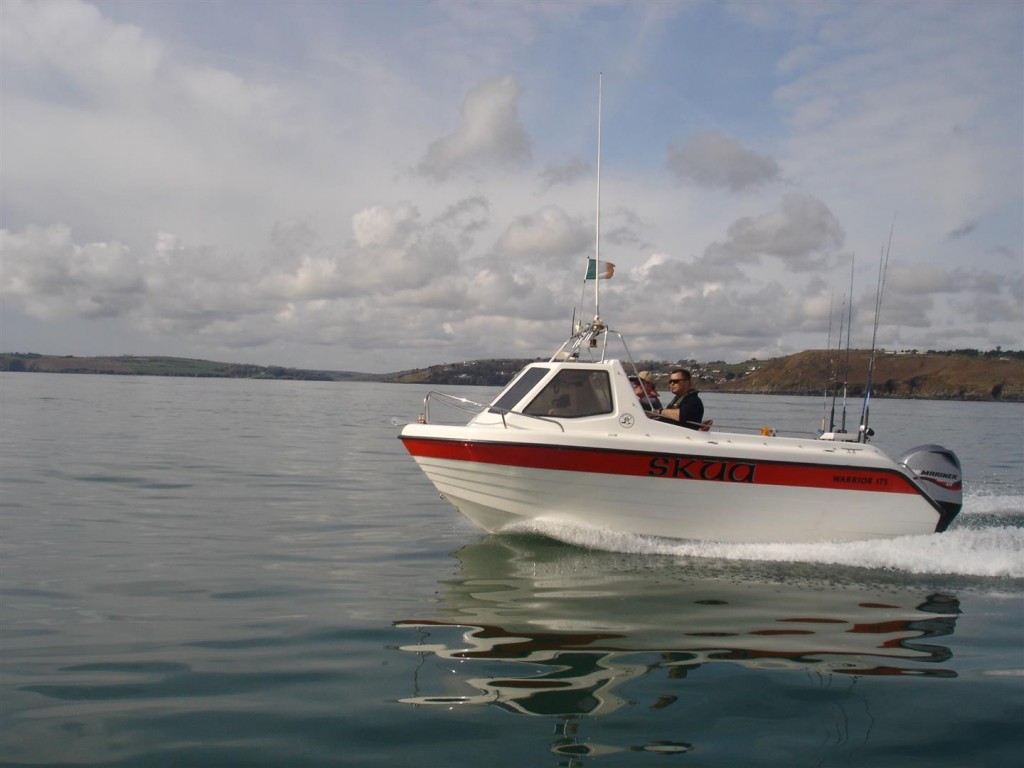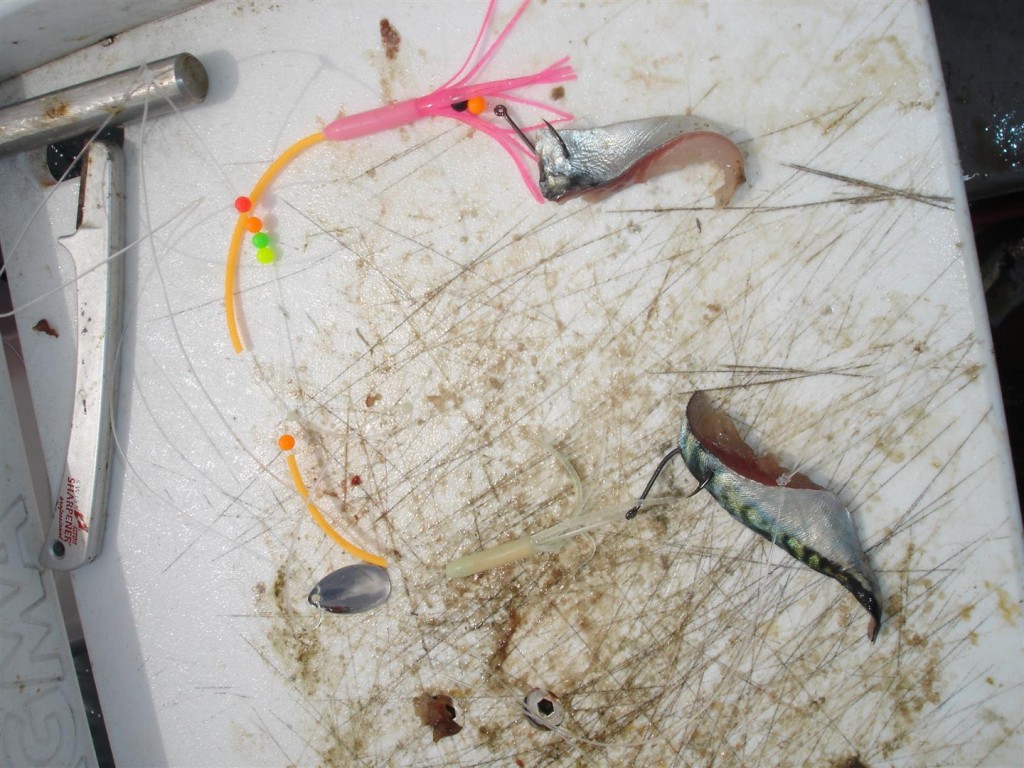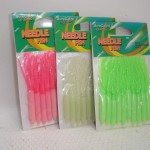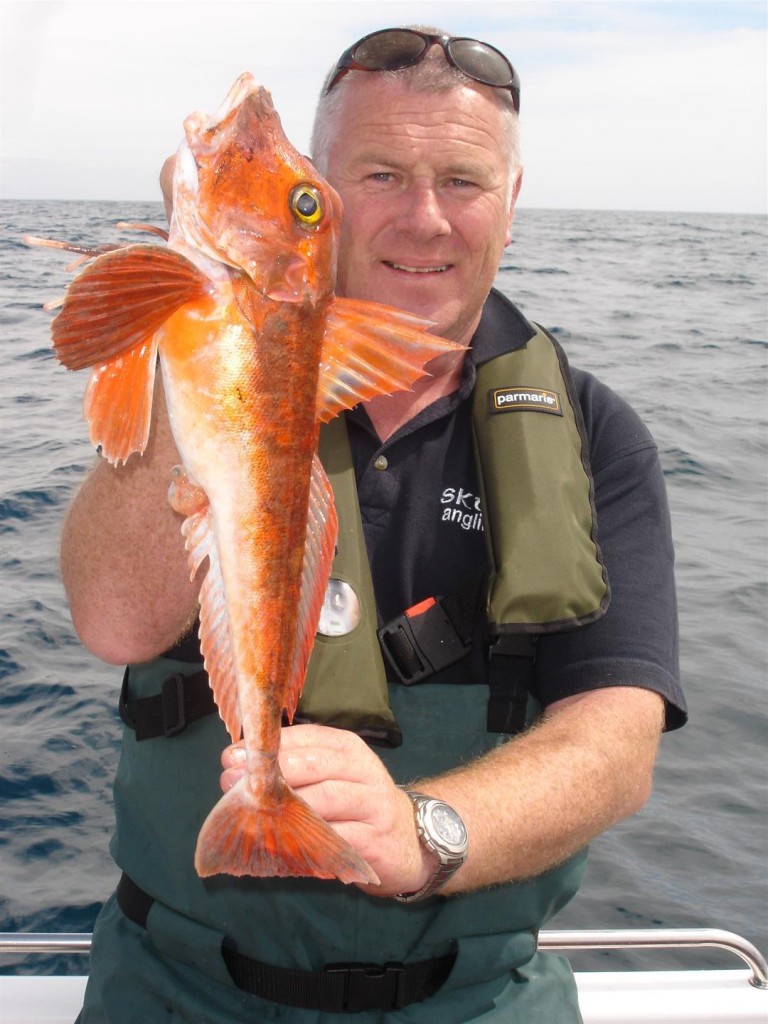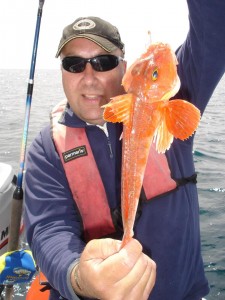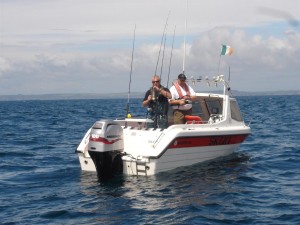Red Gurnards are one of the more spectacular species in our waters. Jim Clohessy sets his sights high and tries to land a big’un. Perseverance pays!
 (Click on any picture to magnify)
(Click on any picture to magnify)
There are realistically three species of gurnard that are common around our coastline. The daddy of them all is the tub gurnard. Unfortunately in the waters around Cork tubs do not grow to the sizes that are available in other parts of the country, tubs down this way hardly grow over two pounds. Grey gurnards are common but bigger specimens are more an incidental catch rather than a species that can be targeted. I think this has much to do with the fact that they are widely dispersed and can be caught almost anywhere. Gurnards are a spirited fish and will give a great account of themselves when they are caught on suitably weighted tackle. While we may not have the lunker tub gurnard of the north coast, down this way in Cork we do have a good population of the next best thing – red gurnards. Red gurnards tend to disappear during the winter months when the water is coldest. They must be fairly tolerant of coldish water because they are one of the first of the summer residents to arrive back inshore and they hang around from May until the water begins to get chilly in November so throughout the summer there is always the chance of picking up a few of these spectacular fish.
When chasing reds the “area” rather than the “mark” is the main thing to consider. That is the beauty of red chasing – it is more than likely that you will have to put the time into covering ground and therefore it is likely that you will catch a variety of species that will inhabit the same area. I take it you are getting the picture – chasing reds is a scratching affair, simple traces, light rods, light tackle and lots of fun are the order of the day.
So where to go? In recent years Cork has proved itself a cracking venue for reds. There are venues around the country that produce big fish each year especially Downings and Brandon in Kerry. In Cork the area of ground north of the ling rocks is the ultimate red gurnard venue. The ling rocks are located around twelve miles from the mouth of Cork harbour so the weather has to be kind to allow you to make your trip. In Kerry the ground off Brandon head produces good reds and even the occasional big tub. Again the weather in Kerry can be fickle and the swells from the west can be spectacular so take care to check your forecasts before making the trips.
Getting to the grounds is one thing; catching fish is another, getting the most out the fish is another matter again. You are not chasing monster fish. A specimen red gurnard weighs in at two pounds in old money so it is better to fish with lighter gear. The biggest obstacle to fishing light will be the depth of water and the speed of drift so you should set yourself up accordingly. A rod in the 6-12lb class should be ideal. I use a variety of rods but my go to road of the moment is a Daiwa Kensaki 6/12 with a Penn 525 reel loaded with 30lb Surecatch Eco-Fibre braid. The rod should be able to cope with six ounces of lead and a baited trace. My setup has dealt with plenty big ling and pollack but is sensitive enough to register the smallest of bites so it is ideal for the whiting, cod, haddock and small ling that should make up the other species that we are sure to catch while fishing for gurnards.
Bait couldn’t be easier! There is no better bait than a thin strip of fresh mackerel bait. Frozen bait may catch but for me the arrival of the first mackerel of the year gets me thinking of gurnards. I think it is not possible to get the presentation required from frozen mackerel. I like a long thin strip of bait that flutters well in the water and I like to hook it just once near the end of the strip. Frozen bait tends to be soft and will fall or gets pulled off easily unlike the tougher freshly caught variety.
Choice of trace can be important. Ideally I would fish with a flowing or leger trace with plenty of bling and a couple of spinner blades. The only drawback to this style of fishing is that on broken ground the loss of gear can be frustrating. Baited Hayabusa sabikis will catch most species on offer and will catch reds but the leger is king. On our first trip of the chase I used more legers but found I was spending too much time rigging after break offs, time that I would rather be fishing. I decided to make up some hybrid traces. I hatched another homemade trace in the shed. I tied up a simple two-hook paternoster with an extra long bottom snood. I like the small but strong hooks that are tied to the Hayabusa sabikis so I tied my traces with either 1/0 Techsharp beak-pattern or with 1/0 Sakuma Chinu hooks. Both patterns have a short shank and wide gape that is ideal for presenting mackerel baits they are also perfect for crab. The Sakuma Chinu’s are incredibly sharp and I did manage to skewer myself while tying but I could see the potential and the advantage these hooks might give me while fishing! I like the Hyabusa Squid Bait style rigs so I searched for a small muppet-style attractor and came up with some three inch Needlefish from Surecatch. These are a fabulous lure that enable the home trace builder make extremely effective rigs. Once you snip off the top with a sharp scissors the Needlefish can be threaded up the snood. I have three colours and all are luminous; I combined these with some beads and spinner blades all tied off using 40lb amnesia. Whether I was going to catch was another matter but I felt ready, and that is half the battle!
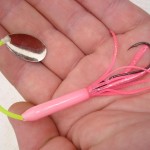
There are no guarantees in angling. You can only put yourself into the right place at the right time with the right tactics, the rest as they say is down to the Gods. We were brimming with confidence that first trip that Danny Kane and myself took out of Cobh. We headed for sea but after a couple of hours of searching for mackerel we resigned ourselves to using frozen mackerel. This was not ideal but was the best we could do, we were lucky to have a few frozen in the first place. We took drift after drift in recognised grounds and other than a few small gurnards we had little else to show. We eventually had to give up and resign ourselves to another attempt. It was at this stage I headed for the shed to hatch some new traces. Our next trip saw Colin Downey and myself launching SKUA in Cobh and speeding towards the ling rocks. This time we were so confident of catching fresh bait we did not bring frozen. After some searching we eventually located a shoal and we had plenty bait within a few drops. We had noticed on our last trip that there were a few other boats fishing the area where we were fishing. We decided to head for different territory as there might be a better chance of a bigger fish in an area that was not being fished as often. We opted to drift a trough of clean ground, an area that we had not tried before. The first part of the drift passed quietly enough then all hell broke loose as we began to catch fish after fish. Colin was delighted with the whiting which were bigger than average. In between whiting we were picking up some ling and codling and the odd red gurnard. Whatever the result this was going to be a nice day’s fishing. Plenty action, light gear, good sport and good company.
Colin was using Hayabusas and could not seem to escape the whiting and ling. The codling seemed to be attracted to my pink Needlefish trace more than the green and I was catching more red gurnards although Colin did have the first few landed on the boat. We released any gurnards we caught. They are a splendid fish to eat but the average sized fish will yield small fillets so unless you are prepared to keep a few bigger fish it is better to release them as soon as possible. It is hard not to wonder at the looks of the red gurnard- a beautiful striking red colour, yellow eyes, big spiky dorsal fin and oversized pectorals. They have a prehistoric quality to their looks that is matched by their ability to grunt, all highly entertaining but be careful when handling them as they have an amount of bony protrusions and spikes. If you are not used to handling any member of the gurnard family then have a damp rag handy or simply t-bar them off at the side of the boat.
We continued our drifting. This is a perseverance game! Every drift I was having at least one gurnard and then a nonstop stream of codling and whiting. Five ounces of lead was just enough to hold bottom. The drift was just under a knot so maintaining contact, and you must maintain in contact with the bottom, was easy. I was just wondering about the lack of haddock when I had a nice bite. I dropped off some line and when the boat caught up with the slack I lifted into what felt like a decent fish. The nonstop diving and head shaking had me betting between a haddock and a good red. I firmly but gently worked the fish to the surface stopping only to shout for the landing net as I saw the flash of red beneath the boat. Colin deftly netted the fish while I proceeded to jump around the deck! I did not need a scales to tell that this fish was the one I had been chasing over the last few trips, a fish over the magical two pounds mark. When I calmed down and weighed the fish it weighed in at close to two and a half pounds. A truly beautiful fish! I spent the next while admiring my catch. Colin in the meantime had rifled my trace wallet to grab one of my traces! We fished on at the mark for another hour, there was no let up in the action from whiting cod and ling but further gurnards failed to reach the magic weight. In the early afternoon our sport was cut short by the quick arrival of a strong sea breeze. With a short space of time the ideal day had turned into a tough spin back to the shelter of the harbour. Colin did not manage to break his gurnard duck but seeing a decent fish being caught only serves to whet the appetite for another trip to the area and another attempt at catching the big one! Back on land we weighed the fish, if you wish to claim a specimen fish it must be weighed on land. The body does not have to be sent to the fish committee but the pictures must leave no doubt that it is a red gurnard you have caught and not just a small tub gurnard. Once we have trailered SKUA and squared all the gear away it is time for a celebratory pint.
It is always great to catch an exceptional fish. There will always be the lucky fish that happens by but it is a good feeling to chase after a particular species until you manage to catch the exceptional one. I have said already that this can be a perseverance game. I have fished for red gurnards every year for the last few years though not as often in recent years. Each year I head for gurnard country and I try my best to be in the right place at the right time. Obviously it does not always happen that you catch the big one but if you do not persevere then you will have no chance of possibly catching the fish of a lifetime. While other species are tougher to pin down in terms of timing there is a whole summer there during which you can target gurnards. It might take some effort and some trace building at home, even a trip to Cork, but it just may be worth it!

